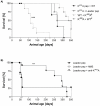A Mycobacterium leprae Hsp65 mutant as a candidate for mitigating lupus aggravation in mice
- PMID: 21961033
- PMCID: PMC3178518
- DOI: 10.1371/journal.pone.0024093
A Mycobacterium leprae Hsp65 mutant as a candidate for mitigating lupus aggravation in mice
Abstract
Hsp60 is an abundant and highly conserved family of intracellular molecules. Increased levels of this family of proteins have been observed in the extracellular compartment in chronic inflammation. Administration of M. leprae Hsp65 [WT] in [NZBxNZW]F(1) mice accelerates the Systemic Lupus Erythematosus [SLE] progression whereas the point mutated K(409)A Hsp65 protein delays the disease. Here, the biological effects of M. leprae Hsp65 Leader pep and K(409)A pep synthetic peptides, which cover residues 352-371, are presented. Peptides had immunomodulatory effects similar to that observed with their respective proteins on survival and the combined administration of K(409)A+Leader pep or K(409)A pep+WT showed that the mutant forms were able to inhibit the deleterious effect of WT on mortality, indicating the neutralizing potential of the mutant molecules in SLE progression. Molecular modeling showed that replacing Lysine by Alanine affects the electrostatic potential of the 352-371 region. The number of interactions observed for WT is much higher than for Hsp65 K(409)A and mouse Hsp60. The immunomodulatory effects of the point-mutated protein and peptide occurred regardless of the catalytic activity. These findings may be related to the lack of effect on survival when F(1) mice were inoculated with Hsp60 or K(409)A pep. Our findings indicate the use of point-mutated Hsp65 molecules, such as the K(409)A protein and its corresponding peptide, that may minimize or delay the onset of SLE, representing a new approach to the treatment of autoimmune diseases.
Conflict of interest statement
Figures






Similar articles
-
Administration of M. leprae Hsp65 interferes with the murine lupus progression.PLoS One. 2008 Aug 21;3(8):e3025. doi: 10.1371/journal.pone.0003025. PLoS One. 2008. PMID: 18716655 Free PMC article.
-
Comparison of epitope specificity of anti-heat shock protein 60/65 IgG type antibodies in the sera of healthy subjects, patients with coronary heart disease and inflammatory bowel disease.Cell Stress Chaperones. 2012 Mar;17(2):215-27. doi: 10.1007/s12192-011-0301-7. Epub 2011 Oct 29. Cell Stress Chaperones. 2012. PMID: 22038196 Free PMC article.
-
Autoantibodies to human heat shock protein (hsp)60 may be induced by Escherichia coli groEL.Clin Exp Immunol. 1996 Mar;103(3):429-35. doi: 10.1111/j.1365-2249.1996.tb08298.x. Clin Exp Immunol. 1996. PMID: 8608642 Free PMC article.
-
Immunotherapy of tuberculosis with Mycobacterium leprae Hsp65 as a DNA vaccine triggers cross-reactive antibodies against mammalian Hsp60 but not pathological autoimmunity.Hum Vaccin Immunother. 2014;10(5):1238-43. doi: 10.4161/hv.28249. Epub 2014 Mar 7. Hum Vaccin Immunother. 2014. PMID: 24607935 Free PMC article.
-
The Mycobacterium leprae hsp65 displays proteolytic activity. Mutagenesis studies indicate that the M. leprae hsp65 proteolytic activity is catalytically related to the HslVU protease.Biochemistry. 2002 Jun 11;41(23):7400-6. doi: 10.1021/bi011999l. Biochemistry. 2002. PMID: 12044173
Cited by
-
Mycobacterium leprae Hsp65 administration reduces the lifespan of aged high antibody producer mice.Immun Ageing. 2014 Mar 26;11(1):6. doi: 10.1186/1742-4933-11-6. Immun Ageing. 2014. PMID: 24669842 Free PMC article.
-
The Role of M. leprae Hsp65 Protein and Peptides in the Pathogenesis of Uveitis.Autoimmune Dis. 2012;2012:197648. doi: 10.1155/2012/197648. Epub 2012 Aug 27. Autoimmune Dis. 2012. PMID: 22966424 Free PMC article.
-
Premolis semirufa (Walker, 1856) envenomation, disease affecting rubber tappers of the Amazon: searching for caterpillar-bristles toxic components.PLoS Negl Trop Dis. 2012;6(2):e1531. doi: 10.1371/journal.pntd.0001531. Epub 2012 Feb 28. PLoS Negl Trop Dis. 2012. PMID: 22389740 Free PMC article.
References
-
- Ellis J. Proteins as molecular chaperones. Nature. 1987;328:378–379. - PubMed
-
- Georgopoulos C. The emergence of the chaperone machines. Trends Biochem Sci. 1992;17:295–299. - PubMed
-
- Pockley AG. Heat shock proteins as regulators of the immune response. Lancet. 2003;362:469–476. - PubMed
-
- Perschinka H, Mayr M, Millonig G, Mayerl C, van der Zee R, et al. Cross-reactive B-cell epitopes of microbial and human heat shock protein 60/65 in atherosclerosis. Arterioscler Thromb Vasc Biol. 2003;23:1060–1065. - PubMed
Publication types
MeSH terms
Substances
LinkOut - more resources
Full Text Sources
Medical
Research Materials
Miscellaneous

